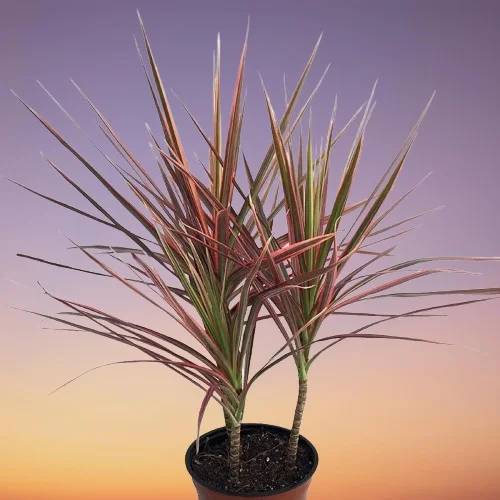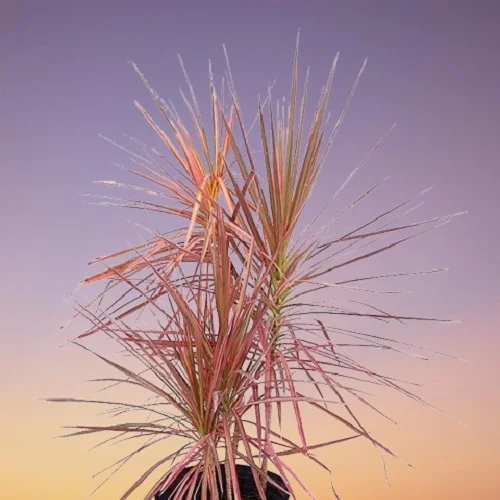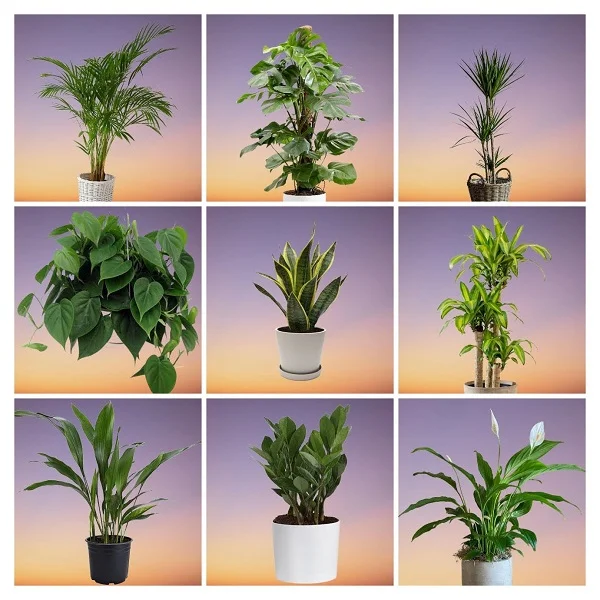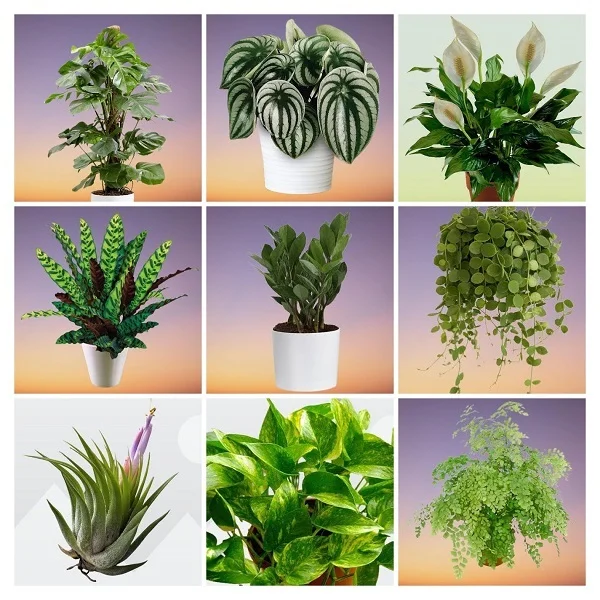Dracaena marginata (Madagascar Dragon Tree) Indoor Care, Common Problems and Solutions
Some links in this post may be affiliate links
Dracaena marginata (Madagascar Dragon Tree) thrives in bright indirect light, average warmth, moderate humidity and moderately moist, rich, well-drained soil coupled with monthly feeding in the growing season.
Whether you want to purify the air, add height to your plant collection, or enjoy a tropical aesthetic, this guide will cover everything you need to know about caring for and troubleshooting Dracaena marginata.
Dracaena marginata is one of the most colorful of the popular Dracaena varieties and easily adapts to a wide range of growing conditions and is also a good air cleaner.
Madagascar Dragon Tree is among the drought-tolerant plants with aggressive root system and is considered to be one of the hard to kill plants you can grow in the home.
The origin of the plant name comes from the word "drakaina" for "female dragon". Madagascar Dragon Tree produces a red gum-like resin in the stems that was likened to dragon blood.
The trunk is tall and snake-like. It will branch with age. When cutback, it will also branch out at a point just below the cut. The narrow, arching leaves are edged with red.
Madagascar Dragon Trees can grow as single-stemmed plants or grouped or even braided together in the same pot.

Botanical name: Dracaena marginata
Family: Asparagaceae
Subfamily: Nolinoideae
Common name: Madagascar Dragon Tree
Origin
Dracaena marginata has its origins in Madagascar and other Indian Ocean Islands.
Size
Madagascar Dragon Tree can grow up to 10 feet high. It is one the best tree-like plants for the home, office and other ideal spaces.
Air Cleaning
According to the NASA Clean Air Study, Dracaena marginata was found to be among the best air-purifying plants and gets rid of xylene, toulene, benzene, formaldehyde and trichloethylene.
Varieties
The most popular varieties of Madagascar Dragon Tree are the basic variety, Dracaena marginata, whose leaves are predominately green and edged with red.
The Dracaena marginata tricolor, in whose leaves a band of yellow separates the green and the red stripes and the overall color is greenish-gold.
Dracaena marginata colorama, where the red banding is more prominent and the leaves appear distinctly reddish.
Is Dracaena marginata toxic?
Dracaena marginata is toxic to both humans and pets as stated by ASPCA. The leaves contain alkyds which are extremely toxic. If ingested they can cause vomiting, diarrhea, drooling, loss of appetite and depression. Keep Madagascar Dragon Tree away from children, cats, dogs, and other pets.
Where to Buy
Dracaena marginata is a magnificent plant to add to any plant collection. Check them out on Etsy (Link to Etsy).

How to care for Dracaena marginata indoors
Caring for Dracaena marginata indoors involves giving it bright indirect light (filtered light), average warmth of 15-280C, moderate humidity of 45-55% and moderately moist, rich, well-drained soil coupled with monthly feeding during the growing season.
Madagascar Dragon Tree care requires potting only when the roots begin to grow through the drainage holes. Pruning is necessary to keep the plant neat, to minimize pests and diseases, to encourage a bushy growth and to rejuvenate growth. Keep reading for more on these growing conditions and how to achieve them.
Watering
How often do you water a Dracaena marginata?
Do not water your Dracaena marginata on schedule to avoid either overwatering or underwatering as both are detrimental to the growth of the plant.
Water your Dracaena marginata thoroughly in spring and summer while allowing the top 2-3 inches of soil to dry out between waterings. Keep the soil moderately moist but never soggy to avoid yellowing and rotting..
Reduce watering in fall and winter to maintain the soil slightly moist as growth is minimal at this time. Do not allow the soil to dry completely to prevent brown, crispy leaf edges.
Avoid soggy soil as it can lead to root-rot. Ensure that the pot has a drainage hole and the soil is well-draining to avoid getting soggy soil.
Use water that is at room temperature to water the plant to avoid shocking this tropical plant which can result in slow growth.
Make sure that the water is free of chlorine, flourides and other chemicals to prevent brown leaf tips.
Light Requirements
How much light does a Madagascar Dragon Tree need?
Madagascar Dragon Tree grows best in bright indirect light (dappled light); position it infront of a well-lit window. Keep it away from direct sunlight to avoid scorching; brown or yellow leaf spots.
Though it can tolerate lower light, it will grow much slower and produce smaller leaves with the less intense color. If the natural lighting is not adequate, you may instal grow lights to supplement it.
Regularly rotate the pot to ensure that the plant receives light on all sides for uniform growth and prevent leggy growth.
Temperature and Humidity
Madagascar Dragon Tree flourishes in average warmth of 15-280C. Keep it away from drafts as the sudden changes it temperatures can cause leaf drop and brown leaf tips.
Dracaena marginata has no need for extra humidity. Average room humidity of 45-55% is ideal for the plant. However, if the air is too dry it can result in brown leaf tips.
Set the pot on a wet pebble tray or instal a cool mist humidifier to raise humidity. You may grow the plant in the humid areas of the home like a bathroom, kitchen, laundry among others. Ensure that there is good airflow for the plant to reduce fungal diseases.
Fertilizer
What is the best fertilizer for Dracaena marginata?
Feed your Dracaena marginata with a balanced, water-soluble fertilizer every 4 weeks in spring and summer to encourage a lush growth.
Stop feeding in fall and winter as growth is minimal and feeding at this time can lead to fertilizer burn which is indicated by brown leaf tips.
Regularly flush out accumulated salts from the soil by running a stream of water through the soil until the water comes out through the drainage hole.
Potting Mix
What kind of soil does a Dracaena marginata like?
The best soil for Dracaena marginata is a light, well-draining soil that does not get soggy. A mix of 50% potting soil, 25% perlite (for drainage), and 25% peat moss or coco coir (for moisture retention) is perfect for this plant.
Repotting
Repot your Madagascar Dragon Tree every 1-2 years at the beginning of the growing season when roots begin to grow through the drainage holes as it grows best when slightly root-bound.
Use a pot at least 2 inches wider than the tree-trunk. Ascertain that the pot has a drainage hole to avoid getting soggy soil. Never allow the roots to sit in soggy soil as it can lead to root-rot and death of the plant. Check out these pots with drainage hole on Amazon.
Pruning & Grooming
The plant is a slow grower and does not require regular pruning. Pruning Madagascar Dragon Tree involves:
- Removal of dead and yellow leaves to maintain the plant neat and discourage pests and diseases.
- Cutting the stem at the desired height; a new sprout of stems will emerge below the cut, to encourage a bushy growth.
This will result in the plant producing several stems instead of having just one stem. The crown of leaves emanating from the pruning, can be used to propagate a new plant.
Occasionally clean the leaves by damp-wiping with a soft cloth to get rid of dust and also discourage pest and disease infestations.
Dracaena marginata Propagation
Dracaena marginata (Madagascar Dragon Tree) can be propagated at beginning of the growing season (spring) by air layering, from stem cuttings or from the top crown of leaves.
Learn how to propagate Dracaena marginata by 4 easy methods.

Dracaena marginata Problems & Remedies
Madagascar Dragon Tree (Dracaena marginata) problems are yellow leaves, brown leaves, dropping leaves, brown leaf tips, plant dying, diseases and pests among others. Keep reading for more on these problems and how to fix them.
Yellow leaves
Why are the leaves on my Madagascar Dragon Tree turning yellow?
The main causes of yellow leaves on your Madagascar Dragon Tree are overwatering, soggy soil, temperature stress, and aging.
How to fix it
Overwatering: Do not water on a schedule. Water only when the top 2-3 inches of soil dry out.
Soggy soil: Use well-draining soil and a pot that has a drainage hole.
Temperature stress: Keep the plant away from drafts emanating from AC units, heat sources, windy doors, drafty windows and others.
Aging: As the plant matures, it sheds the lower leaves. Each lower leaf turns yellow and dries leaving a crown of leaves on top of the cane-like stem.
Brown leaves
Why are the leaves on my Dracaena marginata turning brown?
Some of the causes of brown leaves on your Dracaena marginata are inconsistent watering, soggy soil, and extreme temperatures.
How to fix it
Inconsistent watering: Do not water on a schedule. Water when the top 2-3 inches dry out. Never allow the soil to dry out completely.
Soggy soil: Use a pot with a drainage hole and well-draining soil.
Extreme temperatures: Keep the plant away from drafts emanating from AC units, drafty windows, heat sources, windy doors and others.
Dropping leaves
Why are the leaves falling of my Dracaena marginata?
Falling leaves on your Dracaena marginata are caused by overwatering, underwatering, soggy soil, dry air, temperature stress, and aging.
How to fix it
Overwatering: Do not water on a schedule. Water only when the top 1-2 inches of soil dry out.
Underwatering: Water when the top 2-3 inches of soil feel dry to the touch.
Soggy soil: Use well-draining soil and a pot that has a drainage hole.
Dry air: Set the pot on a wet pebble tray or use a humidifier to heighten humidity. Group the plants together to create a humid microclimate.
Temperature stress: Keep the plant away from drafts emanating from AC units, heat sources, windy doors, drafty windows and others.
Aging: As the plant matures, it sheds the lower leaves. Each lower leaf turns yellow and dries leaving a crown of leaves on top of the cane-like stem.
Brown leaf tips
Why are the tips of my Madagascar Dragon Tree turning brown?
Brown leaf tips on your Madagascar Dragon Tree are due to dry air, underwatering, salts buildup, and cold drafts.
How to fix it
Dry air: Set the pot on a wet pebble tray or use a humidifier to elevate humidity.
Underwatering: Water when the top 2-3 inches of soil feel dry to the touch.
Salts buildup: Use rain water or filtered water to water the plant. Regularly flush out salts from the soil.
Cold drafts: Keep the plant away from cold drafts like windy doors, drafty windows, AC units and others.
Plant dying
Why is my Madagascar Dragon Tree dying?
Your Madagascar Dragon Tree is dying due to root-rot, cold drafts, and salts buidup.
How to fix it
Root-rot: The disease is characterized by yellowing and wilting of the leaves which is rapidly followed by browning and plant collapse.
- Carefully slip the plant out of its pot and inspect the roots.
- Trim brown-black mushy roots and treat the healthy roots with a copper-based fungicidal solution as indicated on the label.
- Disinfect the pot with the fungicidal solution or use a fresh pot to repot the plant in fresh, well-draining soil.
- Do not water the plant immediately; keep it dry for 5-7 days before you resume watering.
- Use a pot with a drainage hole and well-draining soil to prevent the soil from getting soggy.
- Decrease watering in fall and winter as growth is slowed at this time; keep the soil slightly moist.
Cold drafts: Maintain a warmth of 15-280C and keep the plant away from cold drafts arising from drafty windows, windy doors, AC units, heat sources, and others.
Salts buildup: Once in a while, flush out accumulated salts in the soil by running a stream of water through the soil until it drips through the drainage hole.
Pests
Common pests in Madagascar Dragon Tree are spider mites, mealybugs and scales.
How to fix it
- Regularly check underneath the leaves for these pests and take timely control measures.
- Isolate the affected plant to prevent spread to the other plants and treat it with neem oil or insecticidal soap as per the manufacturers' directions.
- Regularly clean the leaves by damp-wiping with a soft cloth to keep the pests away.
- Keep the plant well pruned to reduce the hiding and breeding places for these pests.
Conclusion
Dracaena marginata (Madagascar Dragon Tree) is a resilient, air-purifying plant that adds a touch of modern elegance to any indoor space. By providing the right light, water, and humidity, you can keep this plant healthy and vibrant year-round.
You liked it? Share on social media.
Related Content
Amazon Associates Disclosure
Homeplantsguide.com is a participant in the Amazon Services LLC Associates Program, an affiliate advertising program designed to provide a means for sites to earn advertising fees by advertising and linking to amazon.com.





